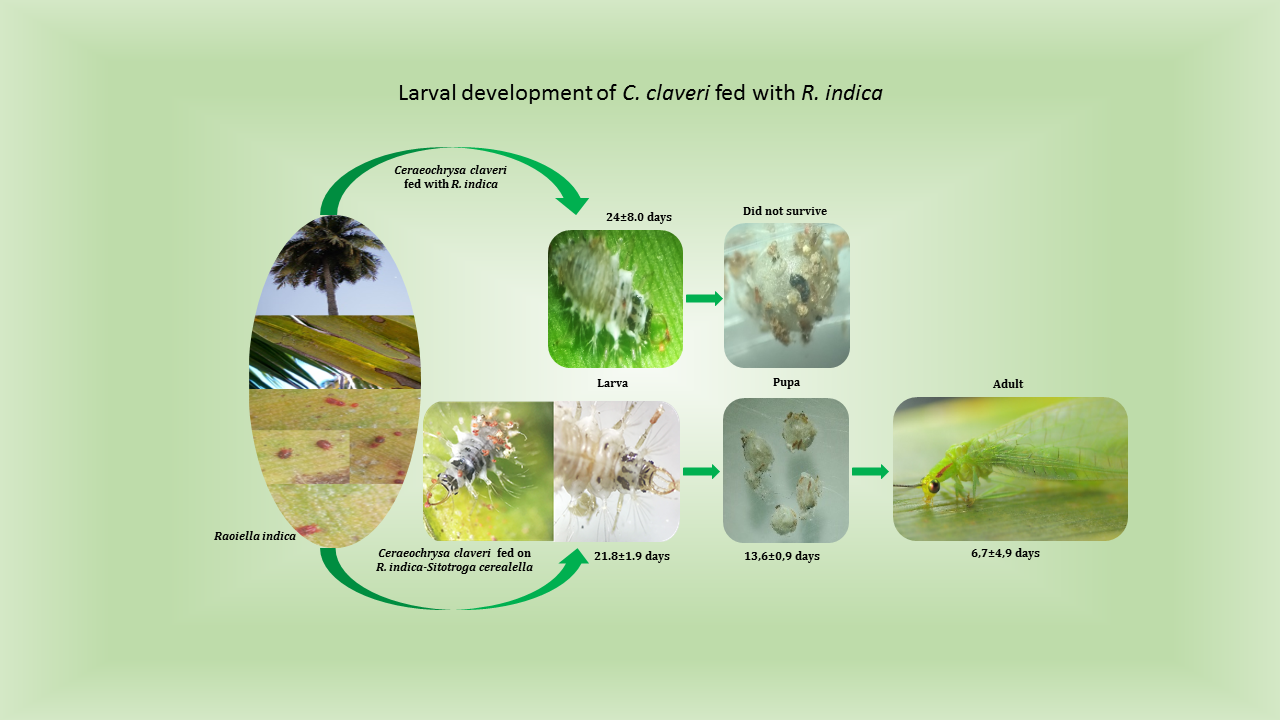Predation capacity and larval development of Ceraeochrysa claveri (Neuroptera: Chrysopidae) fed with Raoiella indica (Acari: Tenuipalpidae)
DOI:
https://doi.org/10.48162/rev.39.055Palabras clave:
depredador, control biológico, ácaro rojo, fitófago, ciclo biológicoResumen
Ceraeochrysa claveri Navás (Neuroptera: Chrysopidae) is a predator found in several agricultural ecosystems and feeds on insects and phytophagous mites. Its high reproductive potential and forage capacity makes it a candidate for biological control of agricultural pests. Raoiella indica Hirst (Acari: Tenuipalpidae) is an important pest that can damage several species of palms, in particular, Cocos nucifera L. Given the scarcity of available knowledge about the biological aspects of Chrysopidae fed with phytophagous mites, the present work aimed to study the larval development of C. claveri fed mainly with R. indica, in order to obtain information that would be of help in the integrated management of this pest. The evaluation was performed in the F0 generation. Larva 3 is the instar that consumes the most mites (F value = 32.99; P > 0.0001) (L3: 46.80 ± 10.12 a; L2: 9.80 ± 1.23 b; L1: 9.40 ± 1.58 b). C. claveri did not complete larval development when fed only with R. indica. Larval instars L1, L2 and L3 lived 7.4 ± 2.2, 7.6 ± 1.9 and 9.0 ± 3.9 days, respectively. The larvae that reached the pupal stage failed to grow further. When adding Sitotroga cerealella Olivier (Lepidoptera: Gelechidae) eggs to the diet, the development lasted 7.9 ± 0.2, 7.4 ± 0.8, 6.5 ± 0.9 and 13.6 ± 0.9 days for L1, L2, L3 and pupae, respectively. The adults lived on average 6.7 ± 4.9 days. The sexual ratio was rt = 0.42. According to the conditions under which the experiment was carried out, it can be inferred is that C. claveri cannot complete its development by feeding only on R. indica, and that it thus consumes this mite as an occasional prey.
Highlights:
- Ceraeochrysa claveri is a predator found in various agricultural ecosystems and feeds on insects and phytophagous mites.
- Raoiella indica is an important mite that can damage several species of palms, in particular Cocos nucifera
- Ceraeochrysa claveri does not complete its biological cycle by feeding only on indica. By adding another protein source to L3, it can reach the adult stage in 35.4±2.8 days.
- Ceraeochrysa claveri does not complete its cycle by feeding only on R. indica and consequently takes this mite as occasional prey.

Descargas
Publicado
Número
Sección
Licencia

Esta obra está bajo una licencia internacional Creative Commons Reconocimiento-NoComercial-CompartirIgual 3.0.
Aquellos autores/as que tengan publicaciones con esta revista, aceptan las Políticas Editoriales.


